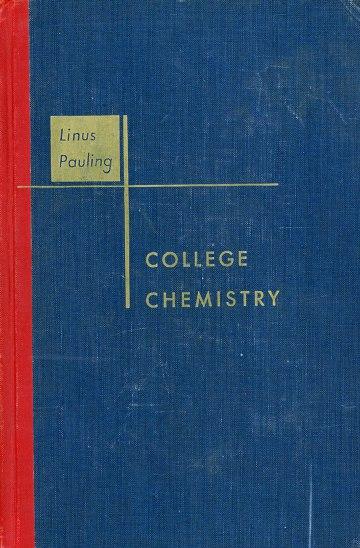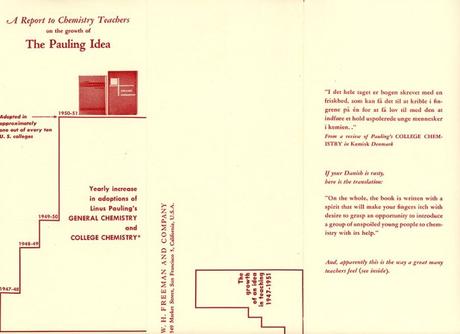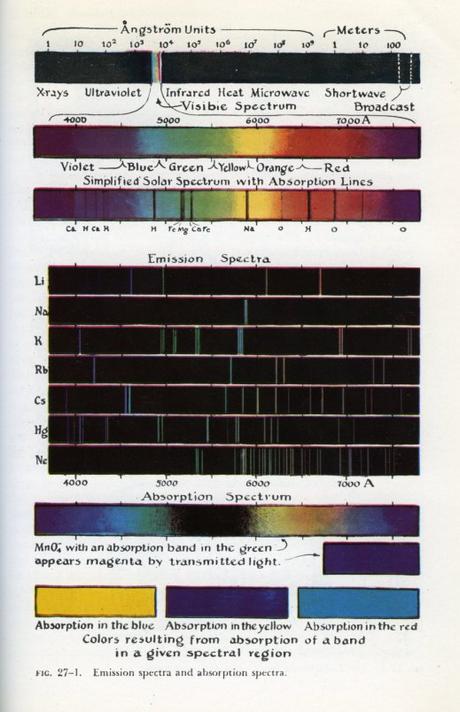
[Part 3 in our series examining Linus Pauling’s relationship with the W.H. Freeman & Co. publishing house.]
Linus Pauling’s landmark General Chemistry textbook hadn’t yet cooled from the press when he, along with publisher Bill Freeman and illustrator Roger Hayward, began planning for a younger sibling, College Chemistry.
Initially, Freeman had expressed high hopes that Pauling might consider writing a chemistry text for liberal arts students and other non-science majors. Pauling suggested another fundamental college text instead. He did so in part because he was troubled by several reviews that had dismissed General Chemistry as being too challenging for a freshman audience. Whether or not this was the case, Pauling felt that he could not adapt his existing book enough to adequately address this complaint. He also did not want to compromise his original intent, which was to give students who were passionate about chemistry a challenging and engaging textbook that would help them to build a strong foundation of core principles within the discipline.
The gap that resided between Freeman’s hopes and Pauling’s goals was ultimately filled by College Chemistry, a text that was specifically marketed as being for the average student. Intent on achieving this objective, Freeman insisted that Pauling’s process rely upon a stable of editors who had absolutely no background in chemistry. Only in this way could the firm verify that this second book would be truly accessible to students lacking in specialized knowledge.

Freeman marketing materials for College Chemistry and General Chemistry, 1951.
As Pauling circulated the first fifteen and then the second fifteen chapters, Freeman became increasingly excited about their new project. Buoyed by these feelings and intent on using what he had learned from their experience with General Chemistry, Freeman laid plans for an early and aggressive advertising campaign.
He and Pauling, however, had different ideas about the specifics of a successful marketing strategy. In one instance, Freeman sent Pauling an ad that depicted nuclear fission with the following caption:
The above picture, of course, shows the process of nuclear fission. But it might also illustrate the way Linus Pauling’s College Chemistry has hit American colleges. Has this chain reaction hit you?
Upon seeing this, Pauling replied that the ad gave him the feeling of a text that had somehow disrupted American colleges, noting that “Whatever the disrupting effect is, it seems to be that it would be undesirable.” Freeman quickly learned his lesson and steered away from science puns in future marketing attempts.

Hayward color plate included in College Chemistry, 1950.
Despite their hectic schedules and a few setbacks, Pauling and Freeman managed to get College Chemistry published by 1950. The new book succeeded in reaching a wider audience than had General Chemistry, and the reviews that it received were largely positive. Pauling dedicated the book to his doctor, Thomas Addis, with the epigraph, “who in supplying science to medicine kept always uppermost his deep sympathy for mankind.”
Shortly after sending the first edition off to press, Pauling was already working on revisions to College Chemistry. Though generally pleased with the work, he felt that there was room to further refine the writing and presentation of information. He also wanted to update the design. For instance, when he saw the color plate for a proposed illustration, Pauling was so impressed that he asked if they could print all of the second edition’s illustrations in color. Though the newer technology excited him as well, Freeman denied this request, citing cost as a barrier. Indeed, such was the state of publishing at the time that Freeman felt they were already ahead of their competitors with the inclusion of a single color plate.
Despite the warm reception that College Chemistry received, Freeman warned that Pauling would have to make substantial revisions to further improve the accessibility of the text and to integrate new scientific developments that had come about between editions. Pauling heeded this warning and saved $300 of his royalties to recruit Fred Allen – then of Purdue University but formerly his professor at Oregon Agricultural College – to assist with the editing. At Freeman’s request, Pauling also circulated his manuscript to non-science professionals, once again seeking to ensure that the text would reach its target audience.
Another key change between the first and second edition was the royalty agreement governing Pauling’s work for Freeman. As the company was still in its early years and in the midst of growing pains, Freeman proposed that Pauling receive a royalty of 10% for the first 10,000 copies (as opposed to their earlier contract, which stipulated a 15% royalty for the first 5,000 copies), 15% for the next 5,500 sold in a year, and 19% on all other copies sold in a year.
Pauling agreed to these new terms for two reasons. First, it was his desire that the company’s success continue. And second, the lower royalty rate meant that Freeman could sell the book at a lower list price. These compromises worked to increase distribution potential and, indeed, both author and publisher saw a satisfactory number of copies leaving the shelves.
Advertisements